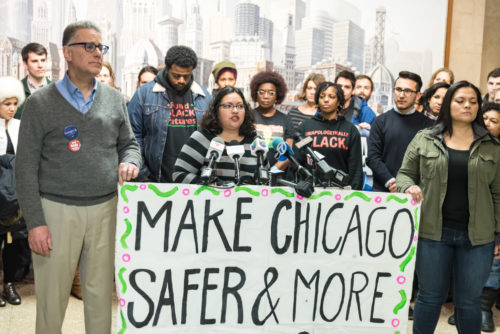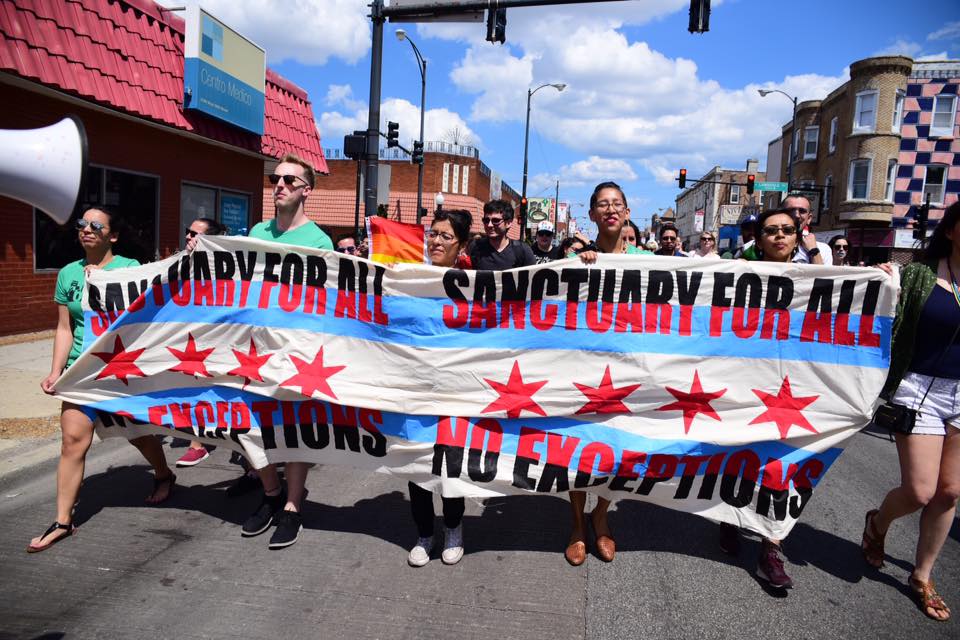In late January, by a vote of forty-one to eight, the City Council strengthened Chicago’s sanctuary city policy by removing exceptions that allowed the Chicago Police Department (CPD) to work with Immigration and Customs Enforcement (ICE) to deport immigrants. Removing the loopholes puts Chicago closer to becoming a true sanctuary for our Black and brown communities—one where our communities are not criminalized, but supported and protected. This victory towards making Chicago a true sanctuary was made possible by “inside/outside” organizing led by undocumented Chicagoans over the past five years.
The inclusion of exceptions in our city’s sanctuary ordinance short-circuited our Constitution’s due process protections. The exceptions left unprotected individuals with outstanding criminal warrants, individuals with prior felony convictions, individuals with pending felony prosecutions, and individuals identified in the city’s gang database. They allowed people to be deported before they had their day in court to contest their criminal charges and denied those listed in the gang database the opportunity to challenge their classification as a gang member.
These exceptions promoted the criminalization of our community and hinged our city’s sanctuary protections on whether or not members of our community were deemed criminal, and therefore, disposable.
Chicago’s movement to create a clear line of separation between local law enforcement and federal immigration enforcement began in 2015, following the formation of the Chicago Immigration Working Group (CIWG). The CIWG was formed by the undocumented immigrant-led Organized Communities Against Deportation (OCAD), the Illinois Coalition for Immigrant and Refugee Rights (ICIRR), nearly a dozen immigrant advocacy and community organizations, and with support from the 35th Ward aldermanic office and other progressive aldermen.
In August 2015, our coalition announced six municipal immigration policies that the City of Chicago could implement in order to become one of the country’s most immigrant-friendly cities. In addition to calling for removing the exceptions from our sanctuary city ordinance, we also called for the city to provide pro bono or low-cost representation to low-income residents facing deportation; expansion of the city’s language access services; creation of a municipal identification card for all Chicago residents; additional support for DACA applicants and recipients; and improved city support services for immigrants who are survivors of crime.
Following the announcement of our municipal immigration policy platform, we began meeting with then-Mayor Rahm Emanuel’s office. While we received positive feedback and action on some of our policy recommendations—namely support for DACA applicants, expanding language access, and creation of a municipal ID—we faced major opposition from the Emanuel administration on removing the exceptions from Chicago’s sanctuary city ordinance.
So we did what organizers do: we upped the grassroots pressure. Through press conferences, letters to the editor, outreach to aldermen, outreach to the mayor’s office, and direct action, we uplifted the need to remove the loopholes from the sanctuary city ordinance. And despite fear-mongering that insisted law enforcement, in this case CPD and ICE, must be allowed to criminalize and dispose of some of us, our community mobilized a united front. We could not allow Chicago to promote an image of sanctuary all while criminalizing and disposing immigrants.
Every time we escalated and publicly pressured Mayor Emanuel for not doing enough to protect Chicago’s immigrant community, he would respond by enacting one of our policy recommendations. For example, in late 2016, he funded pro bono and low-cost representation to low-income Chicagoans facing deportation. While inclusion of $1 million in Chicago’s 2017 budget to fund immigrant legal defense was a major victory, we didn’t rest on our laurels. It quickly became evident that our fight to create a city that truly welcomed and protected all regardless of immigration status was to be a long, persistent one.

As part of this ongoing pressure, in February 2017, after more than a year of meeting and negotiating with a recalcitrant Emanuel administration, we escalated in the legislative arena by introducing an ordinance to remove the exceptions. We did so with the support of twenty-seven Council sponsors.
Mayor Emanuel would leave office with the exceptions still in place, but because of our continued coordinated organizing efforts, both inside City Hall via progressive council members and outside via campaigns led by our communities building collective power—what we call inside/outside organizing—we won measures that we had called for in our CIWG policy platform: municipal IDs, expanded language access, support for the DACAmented, and funding for immigrant legal defense.
And while passage of our ordinance to remove the exceptions continued to elude us, we managed to make strengthening Chicago’s sanctuary city ordinance a municipal election issue. In the 2019 mayoral runoff election, candidates Toni Preckwinkle and Mayor Lori Lightfoot committed to side with our movement and remove the exceptions from Chicago’s sanctuary city ordinance once and for all.
We can not dismiss that removing the carve-outs occurred during a time of important uprisings against racist policing and the ongoing criminalization of Black and brown communities. Our forty-one to eight legislative win occurred in the midst of important pushes to decriminalize and reclaim resources for our communities—including the push to direct some of the nearly forty percent of the Chicago budget that today goes to CPD towards our communities and the push to erase the gang database that is ninety-five percent Black and Latinx.
Amidst these critical reckonings, Mayor Lori Lightfoot had no other option but to engage, and this morning she signed the ordinance. But the fact that we had to push back against our ordinance being leveraged this past November to sweeten her austerity budget with increased funding to CPD is a reminder that our fight for our city to truly do right by our Black and brown communities has been a tedious one.
While removing the exceptions from our sanctuary city ordinance means the city has implemented all six policies called for by the CIWG back in 2015, there is still much more to be done to ensure Chicago becomes a true sanctuary. In a city grappling with demands to do more to address racist policing, to decriminalize and to fund Black and brown communities, removing the exceptions from our sanctuary city ordinance is the bare minimum of what must be done.
As we look towards winning additional reforms and changes we can look to the lessons learned from undocumented Chicagoans fighting for and winning six pro-immigrant policies in five years: we can win the justice people deserve through organizing with allied elected officials, and through sustained grassroots pressure rooted in our community’s self-love, resilience, and determination.
Carlos Ramirez-Rosa is alderman of Chicago’s 35th Ward, now in his second term. Xanat Sobrevilla is an organizer with Organized Communities Against Deportations and is herself an undocumented immigrant from Mexico with DACA. This is their first contribution to the Weekly.


It’s funny how Mexicans an white Hispanics can flood Chicago but not Hatians. Chicago is becoming Mexico City of the North. An white Hispanics are often as racist towards Blacks an other groups then White European. Blacks are not welcome in little village yet Mexicans move in black community. How are Mexicans able to get these houses? It’s a new form of racism.